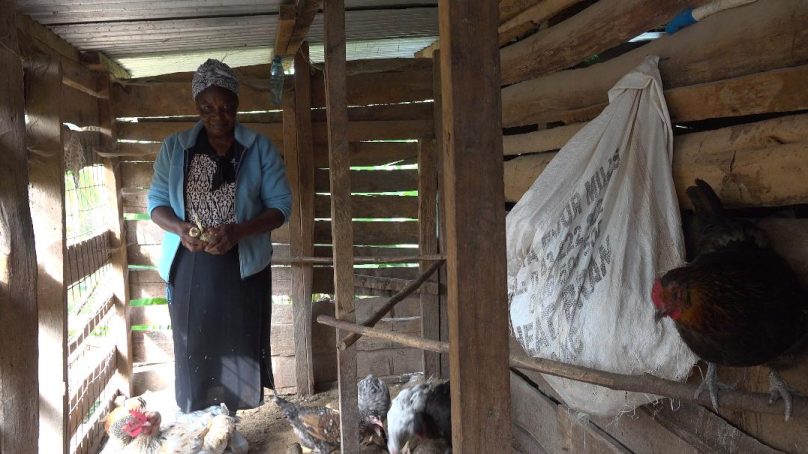
A sloppy farm in Mairang’a village, Gatundu North, Kiambu County, reveals two single-storeyed timber chicken coops. The clucks and squawks are magnified as the owner, Veronica Muchina, broadcasts maize grain in one coop after another.
Muchina keeps a few dairy cattle too. But the mowing of her cattle pales against the sound of chicken squealing that fills the compound. During this visit to her farm, we find her tending dozens of chicks and about 150 adult chickens. The highest number of chickens she’s ever had was 600 in 2022, she says.
Her background a compelling story of a humble beginning. For capital, she inherited three chickens from her mother-in-law.
“There’s no time I’ve never had chicken and eggs,” Muchina says. “So far I’ve the results have been good.”
The three chickens multiplied to a population of 500. “I sold 300 of them and earned Ksh200,000, which I used to pay school fees for my children,” she says. Her market is drawn from the teachers in nearby schools, factories, hotels and her neighbours.
Muchina’s farm is not connected to the national electricity grid. She’s done some improvisation to keep the brood warm and healthy. She uses sheets of nylon gunny bags that line the sides of her chicken pens to retain heat and reduce the cold.
“During the cold season I light a charcoal stove especially when I have chicks,” she says. She ensures that ventilation is sufficient to prevent production of carbon monoxide.
One hen hatches about 30 chicks after which she disposes of the hens to the meat market. She collects at least two trays of eggs per day. She sells an egg at Ksh20. “I pay my farm workers from chicken earnings,” she says.
“My chickens have not been affected by diseases as I have a son who is a veterinary doctor and I regularly consult him.”
However not many farmers are as fortunate as Muchina. Disease outbreaks have wiped out flocks of chicken on many farms in the country. Resuming chicken rearing after such a catastrophic experience has not been pleasant. Consequently, the Kenya Agricultural and Livestock Research Organisation (KALRO) is reaching out to farmers with technology, innovations and management practices (TIMPS) to cut down on losses, particularly mortality.
A KALRO veterinary doctor Wilfred Mutisya, based at Dairy Research Institute (DRI) in Naivasha, says chickens are affected by many diseases.
“There are viral, bacterial and fungal infeections. The fungal ones are either mycotoxins or aflatoxins.”
Mutisya identifies Newcastle – an infectious bursal disease, bronchitis and Mareks among others, as the most lethal. Salmonella and Escherichia coli (E. coli) are among the bacterial diseases that affect chicken most.
Some farmers have procured incubators to hatch their eggs. This is a precautionary measure to limit the spread of pathogens into the farm. Mutisya points out that recommended vaccines are a must.
“The Newcastle jab is given soonest after hatching,” he says. It’s important to adhere to the stipulated vaccination schedule for chicken.
The schedule lists infectious bursal disease (Gumboro) and Mareks as the others to be administered on day one. For Mareks, the route of administration is through the subcutaneous lining while an aerosol spray does it for the others.
When the chicks are 10-12 days old, vaccination against Newcastle and infectious bronchitis has to be administered through water. These are vaccination boosters.
At 18-21 days, a booster vaccination through water should be carried out against Gumboro. At six weeks, the fowl pox vaccine is necessary. It’s a wing web jab. At eight weeks, the fowl typhoid vaccine through intramuscular injection is administered. At 18 weeks, the Newcastle disease vaccine either through eye drops or drinking water is done.
The schedule warns, “Never vaccinate sick chicken.” It urges: “Consult your veterinary/livestock expert for a detailed program in your area.
Mutisya says, “These steps ensure that the birds attain full immunity.” His colleague, Ochieng’ Ouko, recognises that the KALRO TIMPS have significantly boosted the survival chances of chicks.
“We have reduced chick mortality from 50 per cent to only five per cent at household level in Bomet County,” he says.
On parasites, Dr Mutisya knows how much parasites can be a nuisance. “There are two categories. These are external and internal,” he says. Fleas top the list of external parasites. “They irritate the birds causing them stress,” he says, adding: “Once the birds are stressed, they cannot produce to their full potential.”
The veterinarian explains that the parasites also suck blood, leading to anaemia. If the number of parasites is too high, a farmer is likely to lose some of the birds.
Chicken houses with cracks or crevices in the walls are likely to harbour soft ticks, which are notorious parasites. They emerge at night to feed and return to their hideouts during the day. To deal with this menace effectively, a farmer should apply recommended insecticides in the chicken house.
Mutisya identifies mites as other external parasites that the farmer needs to be alert to keep at bay. “These normally burrow under the skin or the scales of the legs of chicken,” he says. “Others burrow under the feathers irritating the birds.”
The birds pluck off their feathers to fight off the irritation and stress set in. “For those that burrow under the skins of the legs, lameness may result, which in turn hampers birds’ movement to feeders. Production drops,” the doctor says.
The last category of external parasites is lice.
“These are found at the base of the feather follicles,” Mutisya says.
These too cause a lot of irritation and stress.
The vet advises, “A farmer needs to always have a programme to control external parasites to ensure that the birds attain full production potential.”
Included in internal parasites are roundworms and tapeworms among others. “Deworming should be done from 19 weeks with a repeat after three months,” Mutisya explains.
And to control external parasites, a farmer can dip his birds in chemical baths known as acaricides. This chemical is subdivided into a miticide, which kills mites and an ixodicide, which eliminates ticks. The mixing proportions differ from one to the other. The manufacturer’s instructions need to be followed.
Mutisya demonstrates how to do it with one kind of acaricide. He measures 20 litres of water in a bucket and then 15 millilitre of the chemical which he pours into the bucket. He recommends the solution to ensure that it mixes well.
The chicken is then briefly wholly immersed in the chemical solution, ensuring that it doesn’t enter the chicken’s mouth and into its digestive system. These disease and parasite control measures can prevent the contamination of the entire value chain.
One of the biosecurity measures that farmers should have are disinfectant footbaths. These are pools of chemical solutions that kill harmful pathogens that can be transmitted by shoes, vehicles or equipment. The chemical composition of the baths varies. Ingredients include hydrogen peroxide, glutaraldehyde or quaternary ammonium compounds (QACS). The manufacturer’s instructions should be adhered to.
These chemicals ensure the disinfection of footwear before entering into the chicken premises. However, farmers are dissuaded from having a stream of visitors to their chicken farms except when necessary.
If vehicles enter the chicken farm, their tyres should run through the bath pool. The vehicle’s driver should exit to disinfect the soles of their shoes. Entire vehicles might even have to be fumigated.
A quarantine area for chickens that appear sick or are sick is necessary. This would minimise the spread of diseases to the rest of the flock. On feeds, if birds have poor nutrition, they will likely have coccidian – a common microscopic protozoan parasite of the gastrointestinal (GI) tract. The illness that arises from this condition is coccidiosis.
The state arises in humid environments. This might happen when drinkers are spilling a lot of water within the litter material. Stunted growth arises and even mortality.
Chicken farmers in the country have decried the high cost of chicken feed. But the KALRO-improved indigenous breed forages for food. This cuts down on the cost of feeding for farmers who don’t have the economic muscle.
The Non-Ruminant Research Institute Coordinator Peter Alaru says KALRO has been working on several feed formulations.
“These formulations are based on different feed ingredients to suit different areas that grow maize, cassava and sorghum as sources of energy,” he says.
The scientist also discloses that KALRO has worked on alternative protein sources. “The black soldier fly (BSF) can replace the soya bean and fish meal,” he says.
Whereas the cockroach is generally viewed as a household nuisance, Kalro has researched and recommended it as an ideal source of protein. Farmers can even learn from KALRO how to breed the insect!
Further research is being conducted on plant-based protein sources such as Moringa leaf meal, azolla and silkworm. “After verifying the results, we’ll release them,” Dr Alaru says.
- A Tell Media / KNA report / By William Inganga








